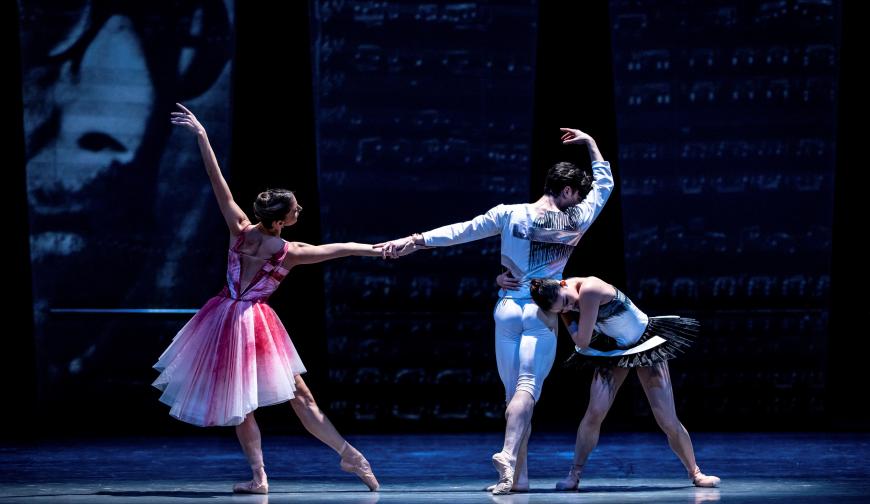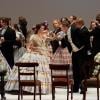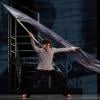
Bay Area dance lovers are in for a treat from renowned choreographer Yuri Possokhov over the next few weeks. Possokhov’s evening-length Anna Karenina, performed by The Joffrey Ballet, will be at Berkeley’s Zellerbach Hall March 15–17, presented by Cal Performances. Then, his Violin Concerto, to Igor Stravinsky’s work of the same title, will be reprised at San Francisco Ballet, April 2–13 at the War Memorial Opera House.
The Ukrainian-born Possokhov graduated from the Bolshoi Ballet Academy in 1982, joined the Bolshoi Ballet, and rose to be a principal dancer. After 10 years, he joined the Royal Danish Ballet. Performing there in Helgi Tomasson’s version of Sleeping Beauty led to an invitation to guest in San Francisco, and a year later, in 1994, the SF Ballet artistic director offered him a position as principal dancer.

Possokhov met the Joffrey Ballet’s now-artistic director, Ashley Wheater, when he came to San Francisco. Possokhov recalls, “Actually, he is the first dancer I met when I came here, when we performed at some city in Southern California. I didn’t speak English at all, so he took care of me.” They later shared a dressing room at the War Memorial.
Possokhov’s first ventures into choreography started when, as he recalls, “I’d been injured, and I didn’t want to waste time, so I asked Muriel Maffre [then a principal with SF Ballet], who I admired so much, ‘Can I do something for you?’ I did a piece on her. It was a solo: Spanish music, Spanish songs. She performed it, I don’t remember when. It was a long time ago.”
Possokhov’s first commission for SF Ballet was Magrittomania in 2000, part of the “Discovery Program” presented by Tomasson. “He pushed us — Julia Adam, David Palmer, and me — to do it. I just took a chance, and then I started to continue to choreograph. I realized I liked it. And now I love it. It’s my life.”
Magrittomania was an enormous success, earning an Isadora Duncan Dance Award for outstanding choreography in 2001, and eventually was set on the Bolshoi Ballet in 2004. Possokhov went on to make more work for that company. In 2006, he retired from performing and became SF Ballet’s choreographer-in-residence. And he has worked with other prestigious companies internationally, creating both evening-length ballets and shorter pieces.
In 2011, Wheater asked him to create an evening-length version of Don Quixote for the Joffrey and also a shorter piece, Bells. And they’ve continued to collaborate. Wheater says, “I think it was back in 2012 when I said to Yuri, ‘I want you to do Anna Karenina for us.’ When I took over the Joffrey, I thought, ‘What are the things that I really, really love?’ I didn’t know how we would be and how we were doing financially. But the one thing that I always thought about was it would be so wonderful to do a version of Anna Karenina that really spoke to me and to the times that we live in today.”
Wheater continues: “I couldn’t think of a better person than Yuri because, clearly, [Russian-speaking countries] grow up with so much beautiful literature. So Yuri agreed. Ilya [Demutsky] created what is truly a beautiful score, and with the librettist [Valeriy Pecheykin], it was so clear what the journey was, and everybody was on the same track. The designer Tom Pye is someone whose work I had seen in London, and I was so wowed by him. Yuri went to London to meet Pye, and they got on really well. What’s wonderful is that Tom also designed the set for Yuri’s Nutcracker with Atlanta Ballet and designed other productions of his when he did work for the Bolshoi.
“During the whole process of Yuri creating Anna Karenina, the company loved him, and they were so invested. … His time in the studio was so productive. He really did create it in an extraordinarily short amount of time because every day he came in and he was pouring choreography out on the company. We’re really thrilled to be bringing it to the West Coast.”

Possokhov explains his process for Anna Karenina: “It’s impulse, not idea. It’s passion and deciding right now very fast. I would suggest something, and they would accept it. We started with writing the music and the libretto. Everything was happening. It’s momentum, not like a philosophy of how [new work] should be. It’s like giving birth. We did it. I don’t like to talk about how you should be educated to [choreograph a piece], how you should [create] roles, or how you should combine ideas and everything. The more I start to think, the less it happens.”
As to how he feels about his Anna Karenina now, Possokhov confesses, “It’s not new anymore, not at all. I just went to rehearsals now in Chicago. and I don’t remember anything. I looked at the ballet, and I told them, ‘It doesn't belong to me.’ Because the moment you finish something, you let it go. It’s already done.
“I don’t want to concentrate on my past pieces. There are different ballets that I love sometimes more than people think. It doesn’t matter about the success of anything. I think some ballets for me are more important in my life than the most successful ballets.”

Possokhov’s conception for Violin Concerto shows he’s a risk-taker. The score he wanted to use was the same one that George Balanchine employed for his Stravinsky Violin Concerto, which was choreographed in 1972 for New York City Ballet’s Stravinsky Festival, celebrating the recently deceased composer. Possokhov had danced in Balanchine’s piece when SF Ballet staged it. He knew that his version would be an homage to both extraordinary artists but that he would stay true to his own vision as well.
The work premiered last year as part of SF Ballet’s “next@90” festival, along with eight other new ballets. It was easily the best of them all. Later that summer the company presented it at Stanford’s Frost Amphitheater, where Artistic Director Tamara Rojo, with refreshing candor, introduced it and admitted that she had doubted whether it was a good idea to use music linked to Balanchine. Happily, she had been proven wrong, she said, and Possokhov succeeded in both honoring and exceeding Mr. B.
About what’s on the horizon for him, Possokhov says, “In three weeks I start Swan Lake in Hong Kong. I have some ideas, but every time I always think I have to be prepared, I have to read something, I’m not preparing. I’m always waiting till the last moment. But sometimes with aging it’s hard because it’s physically difficult. I’m not young anymore. And even though I’m much older now, I’m still not prepared. So I’m waiting for momentum … not to improvise but to be spontaneous. I’m always looking forward.”
Possokhov admits he prefers making evening-length ballets to shorter ones because “it helps me so much to express myself in full-length ballet. … But it’s very important to do small ballets because it keeps you professional. It teaches you how to make architecture, how to make musicality, and everything.”
He also has a number of subjects that interest him for longer ballets. “I have a library of ideas. I’m sure most of them will never happen, but it’s not up to me. The choreographer used to be the number-one person [at a company], and he decided what ballet he would do, what music, what everything. Now, that’s not the way it works. I think in this world, management and directors of the companies decide, and they commission choreographers to do what they want. It’s a huge question of what is good and what is not. And I think there is less freedom, but sometimes it’s helpful.
“But if we look at the history, the best time for each company — whether it’s New York City Ballet and Balanchine, the Bolshoi with Grigorovich … or anyone — it’s better [artistically] when the choreographer, his mentality, his mind, rules the company and the dancers follow him.
“So maybe it’s much better that management decides what to do, what is more important for the current time, financially at least. I am trying to follow new rules, but the only rule is there are no rules in art. Artistically, first of all, [our current time] is a different aesthetic. It’s a different speed of life. So we are talking about art from our past, but it doesn’t work anymore. It’s different. Now, it’s more like, ‘How are you involved in design, in music?’ So now you’re part of everything. It’s less individual, probably. More unified.
“But we don’t look at dancers as stars anymore. … It’s a problem, too. No one explains to them what they are doing. They have no idea. Speed, speed, speed. No one digesting, no one thinking. New rules, new moment. The technique is at such a high level, I can’t believe it. What I miss in the art right now, it’s passion. There is everything, but there is no passion. People are afraid to express it, [but] I think the stage is the best place to do it.”




